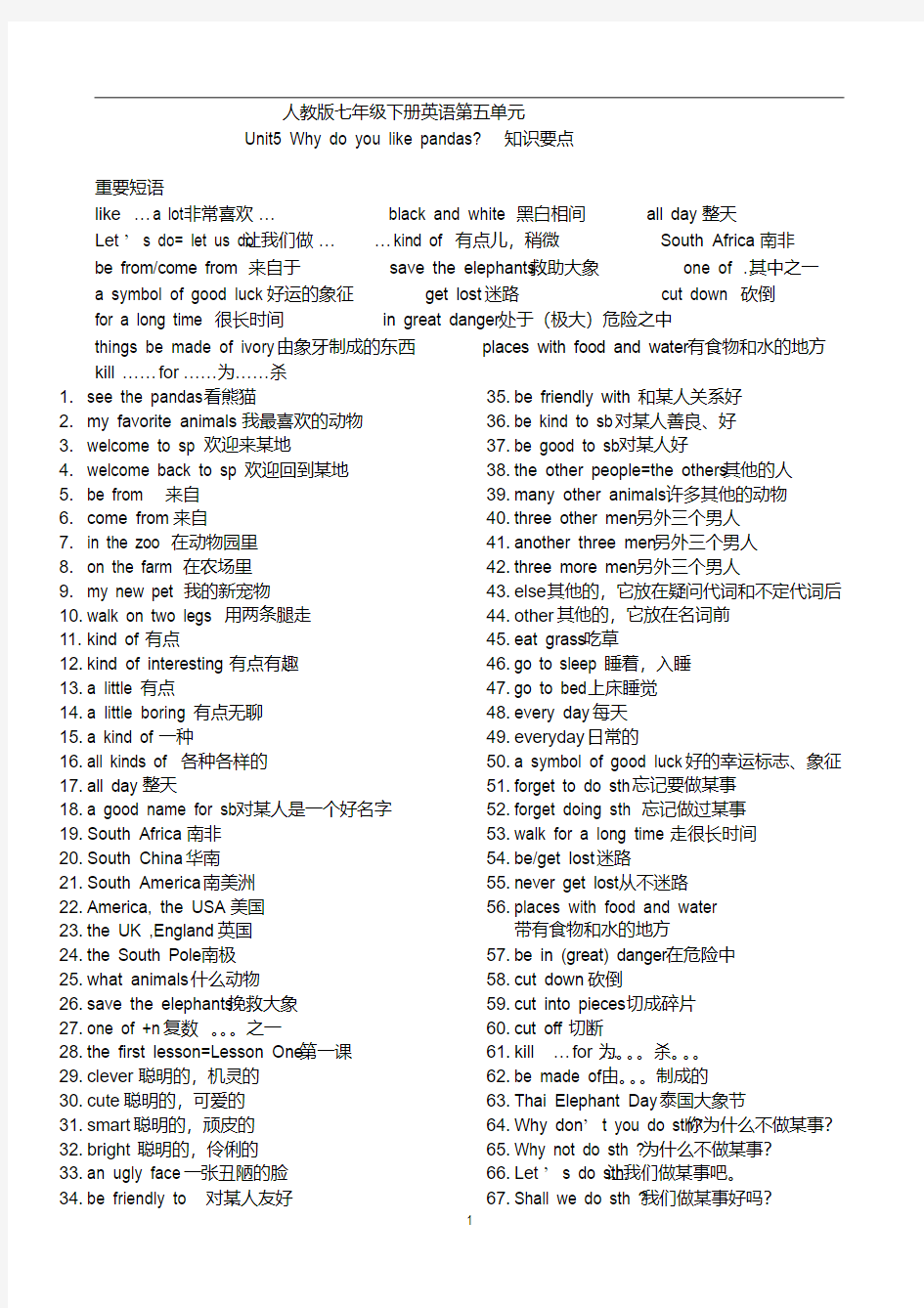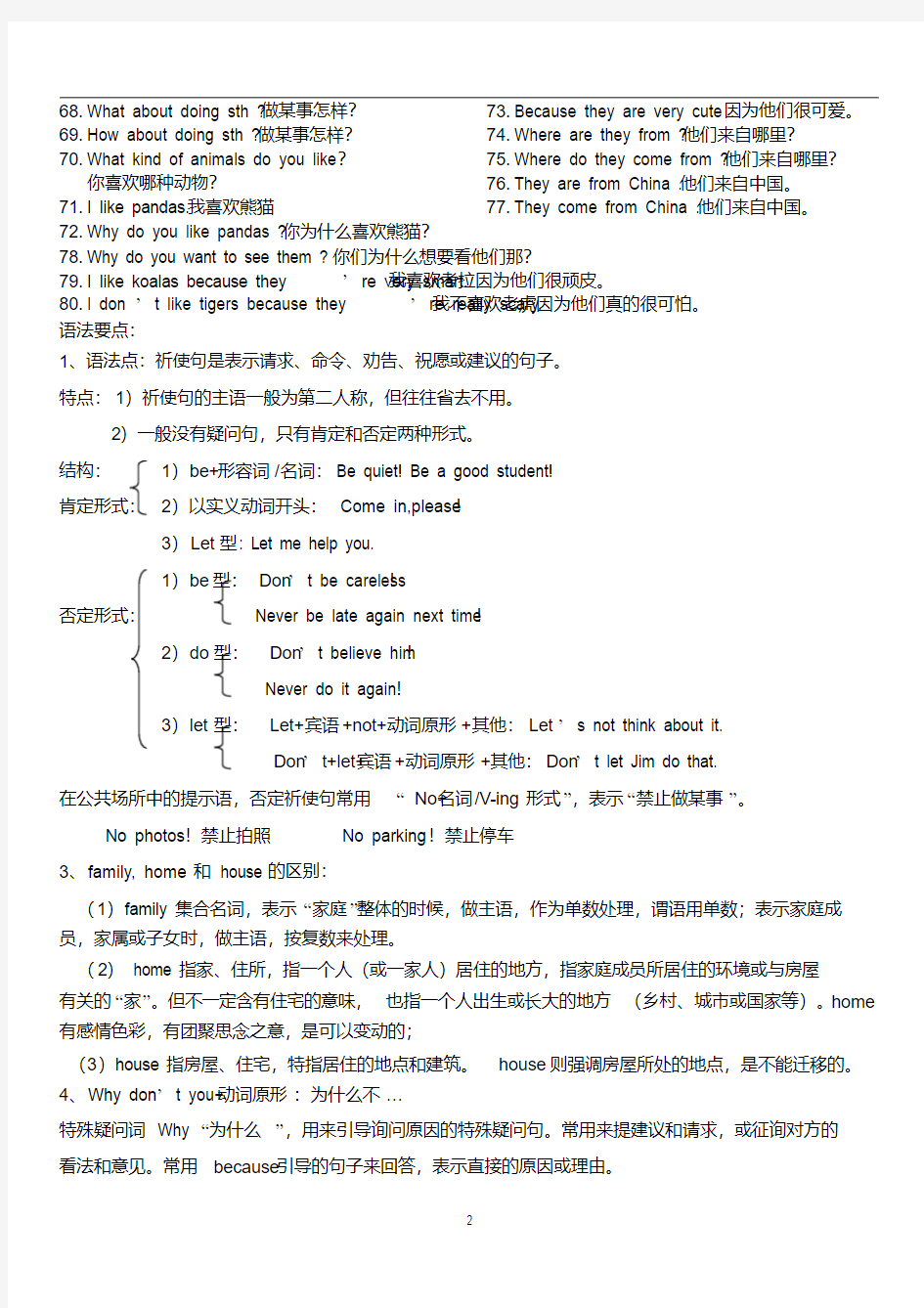(完整版)人教版七年级英语下册第五单元知识点总结


人教版七年级下册英语第五单元
Unit5 Why do you like pandas? 知识要点
重要短语
like…a lot 非常喜欢… black and white 黑白相间all day整天
Let’s do= let us do 让我们做……kind of 有点儿,稍微South Africa南非
be from/come from 来自于save the elephants救助大象one of…其中之一a symbol of good luck好运的象征get lost迷路cut down 砍倒
for a long time 很长时间in great danger处于(极大)危险之中
things be made of ivory由象牙制成的东西places with food and water有食物和水的地方kill……for……为……杀
1.see the pandas 看熊猫
2.my favorite animals我最喜欢的动物
3.welcome to sp 欢迎来某地
4.welcome back to sp 欢迎回到某地
5.be from 来自
https://www.360docs.net/doc/5814842808.html,e from来自
7.in the zoo 在动物园里
8.on the farm 在农场里
9.my new pet 我的新宠物
10.walk on two legs 用两条腿走
11.kind of有点
12.kind of interesting有点有趣
13.a little有点
14.a little boring有点无聊
15.a kind of一种
16.all kinds of 各种各样的
17.all day整天
18.a good name for sb对某人是一个好名字
19.South Africa南非
20.South China华南
21.South America南美洲
22.America, the USA美国
23.the UK ,England英国
24.the South Pole南极
25.what animals什么动物
26.save the elephants挽救大象
27.one of +n复数。。。之一
28.the first lesson=Lesson One第一课
29.clever聪明的,机灵的
30.cute聪明的,可爱的
31.smart聪明的,顽皮的
32.bright聪明的,伶俐的
33.an ugly face一张丑陋的脸
34.be friendly to…
对某人友好35.be friendly with和某人关系好
36.be kind to sb对某人善良、好
37.be good to sb对某人好
38.the other people=the others其他的人
39.many other animals许多其他的动物
40.three other men另外三个男人
41.another three men另外三个男人
42.three more men另外三个男人
43.else其他的,它放在疑问代词和不定代词后
44.other其他的,它放在名词前
45.eat grass吃草
46.go to sleep 睡着,入睡
47.go to bed上床睡觉
48.every day每天
49.everyday日常的
50.a symbol of good luck好的幸运标志、象征
51.forget to do sth忘记要做某事
52.forget doing sth 忘记做过某事
53.walk for a long time走很长时间
54.be/get lost迷路
55.never get lost从不迷路
56.places with food and water
带有食物和水的地方
57.be in (great) danger在危险中
58.cut down砍倒
59.cut into pieces切成碎片
60.cut off切断
61.kill…for…
为。。。杀。。。
62.be made of由。。。制成的
63.Thai Elephant Day泰国大象节
64.Why don’t you do sth?你为什么不做某事?
65.Why not do sth ?为什么不做某事?
66.Let’s do sth.
让我们做某事吧。
67.Shall we do sth ?我们做某事好吗?
68.What about doing sth ?做某事怎样?
69.How about doing sth ?做某事怎样?
70.What kind of animals do you like?
你喜欢哪种动物?
71.I like pandas.我喜欢熊猫
72.Why do you like pandas ?你为什么喜欢熊猫?73.Because they are very cute .因为他们很可爱。
74.Where are they from ?他们来自哪里?
75.Where do they come from ?他们来自哪里?
76.They are from China .他们来自中国。
77.They come from China .他们来自中国。
78.Why do you want to see them ? 你们为什么想要看他们那?
79.I like koalas because they’re very smart.
我喜欢考拉因为他们很顽皮。
80.I don’t like tigers because they’re really scary.
我不喜欢老虎因为他们真的很可怕。
语法要点:
1、语法点:祈使句是表示请求、命令、劝告、祝愿或建议的句子。
特点:1)祈使句的主语一般为第二人称,但往往省去不用。
2)一般没有疑问句,只有肯定和否定两种形式。
结构:1)be+形容词/名词:Be quiet! Be a good student!
肯定形式:2)以实义动词开头:Come in,please!
3)Let型: Let me help you.
1)be型:Don’t be careless!
否定形式:Never be late again next time!
2)do型:Don’t believe him!
Never do it again!
3)let型:Let+宾语+not+动词原形+其他:Let’s not think about it.
Don’t+let+宾语+动词原形+其他:Don’t let Jim do that.
在公共场所中的提示语,否定祈使句常用“No+名词/V-ing形式”,表示“禁止做某事”。
No photos!禁止拍照No parking!禁止停车
3、family, home和 house 的区别:
(1)family 集合名词,表示“家庭”整体的时候,做主语,作为单数处理,谓语用单数;表示家庭成员,家属或子女时,做主语,按复数来处理。
(2) home 指家、住所,指一个人(或一家人)居住的地方,指家庭成员所居住的环境或与房屋
有关的“家”。但不一定含有住宅的意味,也指一个人出生或长大的地方(乡村、城市或国家等)。home 有感情色彩,有团聚思念之意,是可以变动的;
(3)house 指房屋、住宅,特指居住的地点和建筑。house则强调房屋所处的地点,是不能迁移的。
4、Why don’t you+动词原形:为什么不…
特殊疑问词Why “为什么”,用来引导询问原因的特殊疑问句。常用来提建议和请求,或征询对方的
看法和意见。常用because引导的句子来回答,表示直接的原因或理由。
相当于Why not+动词原形。
Eg :Why don ’t we meet earlier ?=Why not meet earlier ?
肯定回答:OK!All right./Good idea./Yes ,I think so. 否定回答:Sorry ,I …/I ’m afraid not.表示建议的句型:How/What about … 怎么样You should do …你应…Let ’s do … 让我们…Shall we do …?我们…好吗Will you please do …?可以请你…吗?
Would you like to do
…?你愿意…吗?
5、all night :整夜all morning :整个上午
all the year :全年
6、save :救助;节省
save one ’s life 救某人的命
save one ’s face 顾全某人的面子
save sth for sb 为某人节省某物
save money :攒钱
save water 节约用水
7、one of+名词的复数形式:"其中的一个"“…之一”.作主语时谓语用单数:
例:one of my friends
going to travel to New York.
One of the students _______(come) from Australia. Two of …:…中的两个Some of …:…中的一些Many of …:…中的许多
All of
…:…中的全部
8.symbol 是一个名词,意为“象征,标记”。常用短语a/the symbol of......表示象征.。e.g .The dove is /the symbol of the peace. 白鸽是和平的象征。9. danger 名词,危险,
be in danger.遇到危险
out of danger.脱离危险
danger 前可用great 修饰,表示“巨大的”.be in great danger 面临巨大的危险,处于极大危险之中e.g.:The boy can be in great danger. 那个男孩会面临巨大的危险。dangerous adj.危险的
Tigers are very dangerous.老虎非常危险。
10. with.介词(1)与...一起,偕同,和...
e.g.:She watches TV with her sister. 她和她姐妹一起看电视。(2)带有...;有...的,其后面接一个名词构成介词短语修饰前面的名词。e.g.:那个长头发的女孩是我同学。The girl with long hair is my classmate
11. forget (v.)忘记
过去式forgot
过去分词forgotten
forget to do sth 忘记要去做某事(事情还没做);
remember to do 记住要去做某事
forget doing sth 忘记曾经做过某事(事情已做,但忘了) remember doing 记得曾做过某事
forget 只表示忘记带某物
leave 把某物忘记在某处
12、固定短语,get lost 迷路=lose one ’s way
13、over:prep:在…上方
遍及We have friends all over the world。
Adv:结束The film is over.
经过The plane flew over about an hour.
14、must用法:用在一般疑问句中,否定回答用needn’t
。
表示推测时,用在肯定中,否定句中用can’t.
Her room is light on. She must be at home. She can’t be out.
【知识点拨】重点词汇及句型用法讲解:
[解析1]. Let’s see the pandas first.
开头的祈使句,表示邀请,建议;意为“让我们…吧”。
这是一个let’s
是let us缩写,后面接动词原形。即let sb do sth
let’s
/All right或OK。
肯定回答用That sounds interesting/ OK./All right./Yes, let’s …
play volleyball, All right.
否定回答用Sorry, I……eg: Let’s
see 在句中是及物动词,意为看见,强调看的结果。你能看见那只鸟儿吗?Can you see the bird ?Look at 强调看的动作。例:
He tried hard to the blackboard, but he nothing。他努力地看黑板,结果什么也看不清。firs t (1)副词。“首先、最初”,我想先回家. I want to go home first.
(2)序数词,表示“第一” 国庆节在十月一日。National Day is on October 1st.
He is the _____(one)student to get there.
[解析2]why do you want to see them?
1)Why 是特殊疑问词,意为“为什么”,用来引导询问原因的特殊疑问句。常用because引导的句子来回答,表示直接的原因或理由。
你为什么喜欢音乐?因为它有趣.Why do you like music? Because it’s interesting.
2)注意:在英语中用because 不用so,或用so不用because 如:
Because English is very interesting, I like it.
)
Because English is very interesting, so I like it. ( ×
3)want sth 想要某物我想要一件蓝色毛衣。I want a blue sweater.
want to do sth . 想要做某事她想先看大象:She want to look the elephants first.
want sb to do sth. 想要某做某事我父母想要要我帮助他们。My parents want me to them.
[解析3]well, because she’s kind of boring.
kind of 是固定用法,“有点儿”,相当于 a little,常用来修饰形容词。
例如:考拉有点害羞。Koalas are kind of shy.I’m kind of hungry.我有点饿
“kind”可做名词,意为“种类”。短语what kind of....哪种
例如: 你喜欢哪种食品?What kind of food do you like?
all kinds of 各种各样的many kinds of许多种类的
different kinds of 不同种类的 a kind of 一种…
例:This is a kind of paper.这是一种纸。
“kind”还可做形容词,意为“善良的、友好的”。
他的妈妈是一个善良的女人。Her mother is a kind woman.
[解析4]she sleeps all day, her name is Lazy.
(1)做动词,意为“睡觉”,后面可跟副词或介词。过去式、过去分词都是slept
“sleep”
sleep well because of noise(噪声)。
e.g:因为噪声我不能睡好。I can’t
sleep 表示睡觉持续的状态,可与表示一段时间的状语连用。另外,也可以做名词
go to sleep “入睡”,表示短暂性动作
go to bed 上床去睡觉,着重指上床去睡觉,没有提到是否睡着。
形容词,(1)意为全部的,整个的,与单数名词连用时,表示某事在某段时间内持续发生。 e.g:“all”
他整日整夜的玩。He plays all day and night.
(2)还可与可数名词复数或不可数名词连用,表示“全部、所有;一切”。此时名词前可用the,this,that, my ,her 等修饰;可数名词复数前还可用数词修饰。
她所有的朋友都在这儿。All her friends are here.
所有的同学放学后都回家了。All the students go home after school.
[解析6] But I like tigers a lot.
a lot 是固定搭配,“很;非常;常常”,,在句中做副词,在句中作程度状语,表示修饰动词、感叹词、介词短语、形容词或副词的比较级。相当于very much.
意为非常喜欢(=like......very much.)
短语“like......a lot ”
例句:玛丽非常喜欢汉堡包。Mary likes hamburgers a lot/( very much)
It usually rains a lot/much at this time of year. 每年这个时候都经常下雨。(修饰动词rain)
Do you wear your new watch a lot? 你常戴你的新手表吗?(修饰动词wear)
多谢,十分感激。(修饰感叹词thanks,thanks=thank you)Thanks a lot/very much ---that’s very kind.
He is feeling a lot/much better. 他感觉好多了。(修饰比较级better)
Your room is a lot bigger than mine. 你的房间比我的大得多。(修饰比较级bigger)
a lot of = lots of,可修饰不可数名词,也可以修饰可数名词的复数形式,“许多”,“大量的”,相当于many或much。a lot, a lot of, lots of通常用于肯定句,否定句中一般用many或much,如:
There’s a lot of work to do and a lot of people have been sent there.
有许多事情要做,许多人已派去那里了。
[解析7]. I like dogs because they’re friendly and smart.
是一个形容词,它是由名词“friend”加上“ly”
构成的,意为友好的.
1、“friendly”
be friendly to sb 对某人友好/友善;be friendly with sb和某人友好相处.和某人关系好
解析8
(1)be made of ... :“某物由……制成”(材料不发生化学变化,从制成品中可以看出原材料)。如:The bookshelf is made of wood. 这个书架是由木头制成的。
(2)be made from ... :“某物由……制成”(材料发生化学变化,从制成品中一般看不出或难以分
辨出原材料)。
如:Paper is made from wood and bamboo. 纸是由木头和竹子制造而成的。Wine is made from grapes. 葡萄酒是用葡萄酿成的
(3)be made up of由…构成、一般是多种构成。
如:Water was made up of oxygen and hydrogen.水由氧气和氢构成。
语法焦点:
原因:
①---Why do you like pandas? ---Because th ey’re kind of interesting.
②---Why does John like koalas? -- Because they’re very cute
③—Why don’t you like tigers?--Because they’re really scary.
地点:
--Where are lions from? --They’re from South Africa.
形容词的用法:
形容词修饰名词,用以说明事物或人的性质或特征。形容词是英语中最常用的词性之一,它通常在
句中作定语、表语等。
①作定语修饰名词或代词one,ones,作定语,位于名词或代词之前
This is an old book.这是一本旧书。
I want some large ones.我想要写大的。
②作表语放在连系动词(be/look/feel/sound等)后,作表语,构成系表结构,即“连系动词+表语”,说明主语是什么或怎么样,即说明主语的特性。
They’re cute. 它们很可爱。He looks very happy.他看起来很高兴。
一般形容词在词尾加-ly变成相应的副词形式,以-y结尾的形容词,可以直接变y为I,再加-ly.
多个形容词修饰一个名词,先后顺序
一、OP SH A C O M
OP---opinion评述性词。如beautiful,wonderful,expensive,terrible,
horrible,lovely,silly,ugly等。
SH---size &shape表大些形状的词。如long,short,round,square等。
A---age表新旧的词。如new,old等。
C---colour表颜色的词。如red,black,purple,brown,yellow等。
O---origin表产地的词。如Italian,Spanish,Canadian,Australian,Japanese
M---material表材料的词。如leather,glass,rubber,metal,silk,plastic等。
按此顺序,"一件新的漂亮的意大利的黑皮茄克"的英语为"a beautiful new black Italian leather jacket。"
二、“美小圆旧黄,中国木书房”
注:“美”代表“描述或性质类”形容词;“小”代表“大小、长短、高低、胖瘦类”形容词;“圆”代表“形状类”形容词;“旧”代表“新旧、年龄类”形容词;“黄”代表“颜色类”形容词;“中国”代表“来源、国籍、地区、出处类”形容词;“木”代表“物质、材料、质地类”形容词;“书”代表“用途、类别、功能、作用类”形容词;“房”代表“中心名词”。
例如:
two beautiful new green silk evening dress 两件又新又漂亮的丝绸女士晚礼服;that hungry, tired, sleepy little match girl 那个饥饿、疲劳、困倦的卖火柴的小女孩;an old large brick dining hall 一个旧的红砖砌的大餐厅。
三、限定描绘大长高,形状年龄和新老;颜色国籍跟材料,作用类别往后靠
其中,“限定词”包括:冠词、物主代词、指示代词、或数词,它位于各类形容词前。它本身分为三
位,即:前、中、后。前位限定词有all、half、both、分数和倍数;中位限定词有冠词、指示代词、
物主代词等;后位限定词有基数词和序数词,但序数词位于基数词前。如:both my hands、all half his income等。“描绘”性形容词如:beautiful、bad、cold、great等。“大长高”表示大小、长短、高低等
一些词。表示“形状”的词如:round square等。“国籍”指一个国家或地区的词。“材料”的词如:wooden, woolen, stone,silk等。“作用类别”的词如:medical, college,writing desk,police car等。四、大小形状和新老,颜色国籍出(处)材料
多个形容词修饰同一名词时的顺序是固定的,其顺序为:①冠词、指示代词、不定代词、物主代词+
②序数词+基数词+③一般性描绘形容词+④大小、长短、形状+年龄、新旧+⑥颜色+⑦国籍、出处+⑧材料+⑨用途、类别+⑩最终修饰的名词或动名词。例如: a beautiful little red flower 一朵美丽的小花。those four old-looking,grey,wooden houses 所以这个翻译题我有一个中国制造木制红色的大的园桌子
可以翻译成i have a big,round ,red,wooden,chinese table
